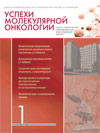Epygenetic regulation of gene expression in virus-associated human tumors
- Authors: Kisseljova N.P.1, Kisseljov F.L.1
-
Affiliations:
- Federal State Budgetary Institution “N. N. Blokhin Russiаn Cancer Research Center”, Russian Academy of Medical Sciences, Moscow
- Issue: Vol 1, No 1 (2014)
- Pages: 48-55
- Section: REVIEW ARTICLES
- Published: 02.06.2015
- URL: https://umo.abvpress.ru/jour/article/view/16
- DOI: https://doi.org/10.17650/2313-805X.2014.1.1.48-55
- ID: 16
Cite item
Full Text
Abstract
Viruses are associated with nearly 20 % of human cancers worldwide. Until recently genetic abnormalities generated by oncogenic viruses
in cells were the main object of studies. Understanding of the importance of epigenetics in the regulation of gene expression prompted the investigation of virus and host interactions at the epigenetic level. We review aspects such as common futures of oncogenic virus interactions with cell epigenetic system and virus-specific peculiarities of these interactions. Knowledge of the regulation of virus genomes by cell epigenetic system and disturbances of this system by viruses should provide us with markers for following cancer progression, as well as new tools for cancer therapy
Keywords
About the authors
N. P. Kisseljova
Federal State Budgetary Institution “N. N. Blokhin Russiаn Cancer Research Center”, Russian Academy of Medical Sciences, Moscow
Author for correspondence.
Email: natalia-kis@yandex.ru
Russian Federation
F. L. Kisseljov
Federal State Budgetary Institution “N. N. Blokhin Russiаn Cancer Research Center”, Russian Academy of Medical Sciences, Moscow
Email: fake@neicon.ru
Russian Federation
References
Supplementary files






